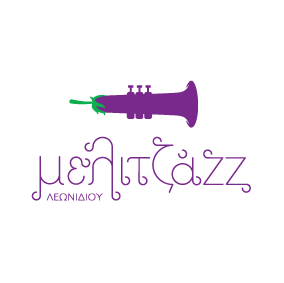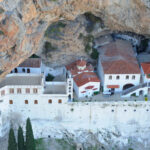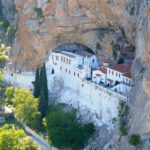Monastery of Agios Nikolaos Sintzas

The monastery of Agios Nikolaos Sintzas is located six kilometres northeast of Leonidio, the capital of the region of Tsakonia. Situated in the fertile valley of the Daphnon stream, Leonidio succeeded the ancient city of Brasies or Prasies, one of the eighteen cities of the League of the Free Lakonians, with sanctuaries of Asklepios and Achilles. The earliest reference to Leonidio is in a 1293 chrysobulle of Andronikos II Palaiologos, which mentions the church of Agios Leonides, from which the town took its name. Modern Leonidio was founded by the inhabitants of Prastos, after this town’s destruction in 1826.
The monastery is built deep into the Leonidio valley, in the cavernous hollows of a solid rock-face dotted with the hermitages of ascetics, who settled there probably in the late sixteenth or early seventeenth century. Deeper hollows were selected and used ingeniously to create a solid, dry, spacious plateau for the main monastic building, which comprises two superimposed wings of cells and guestrooms and a katholikon (main church) in the centre. Shallower hollows house individual hermitages (east of the main building), storerooms, and service areas.
NAME
According to one hypothesis, the monastery’s epithet (Sintzas) derives from the Tsakonian dialect and, more specifically, from the word sytza (sykia = fig tree). Several narratives on the monastery’s establishment and name involve a fig tree that grew inside the cave that was to become the monastery. According to other hypotheseis, Sintza comes from the Turkish words since (made of clay) or sincap (squirrel or other animal used for its fur, or fur garment). In a 1819 testament, the monastery is referred to as Insintza.
The name is written with an iota instead of an upsilon, as it appears in the sigillia, because its relation with the word sytza/sykia is not confirmed.








